-
 308185 Hits
308185 Hits
-
 99.69% Score
99.69% Score
-
 130 Votes
130 Votes
|
|
Mountain/Rock |
|---|---|
|
|
0.6667°S / 78.4333°W |
|
|
Hiking, Mountaineering |
|
|
Summer, Winter |
|
|
19347 ft / 5897 m |
|
|
Overview
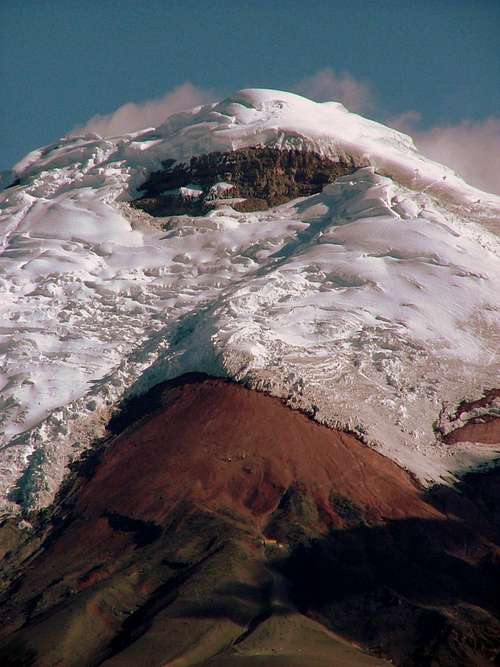
Cotopaxi (5,897 m / 19,347 ft.) Boriss Andean.
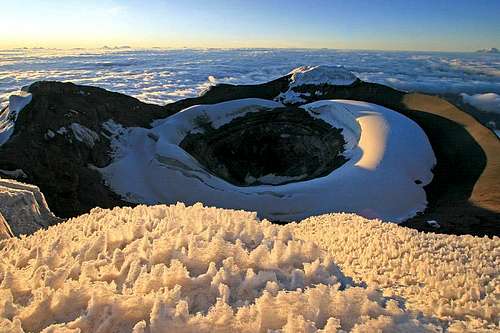
Cotopaxi crater as seen from the north summit. marauders
A bit of history
These are few of the most important events recorded during Cotopaxi’s volcanic activity: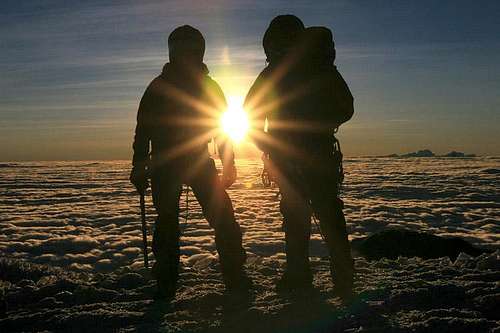
Cotopaxi summit shot. marauders
Getting There
Cotopaxi National Park is located approx. 55km south of the capital city of Quito. This is one of the reasons why Cotopaxi can be seen unmistakably from the north and center of Quito in a clear day or as your plane overflies the city before landing on its airport.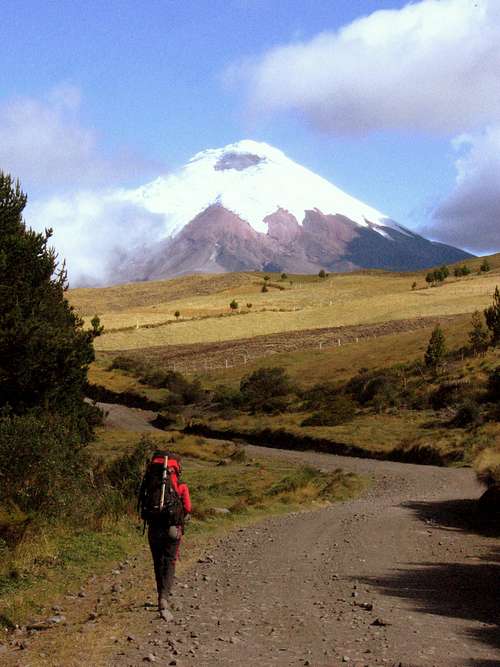
On the way to Cotopaxi. Control Norte, El Pedregal. andreeacorodeanu
Control Norte or El Pedregal:
From Quito (Terminal Quitumbe), take Transportes Mejia (green buses) or Transportes Carlos Brito (purple buses). Both can be found at the eastern side of the terminal, right outside the food court. It’ll take you a bit less than an hour to get to Machachi (the final stop) for only USD. 0.75. Once in Machachi, make sure you get off the bus at the main square or at the market “Mercado Amazonas”, where you can hire a pickup truck for USD. 35,00 one way up to the parking lot (one and a half hours approx.). You can also fix arrangements for your return trip. Machachi is a good option if you have to stock up on last minute supplies. There are many small stores (tiendas), bakeries (panaderias), internet access, restaurants all over town. You can even find a big market (Almacenes Tia) where you can get some provisions for your trip. Optional transportation: There’s a bus company “Transportes Machachenas” a block away (north) from the main square. These buses leave every 45 minutes – 1 hour towards El Pedregal (USD. 0.50), which is a village located half way to the north entrance. From there you’ll need to hike to the north entrance for about 1 hour and about 5 hours to the parking lot. There’s not much traffic going that way, therefore catching a ride would be difficult. This is a good option for saving a few bucks, not for saving energy for the climb, though.Control Sur or El Chaspi:
From Quito (Terminal Quitumbe) take any of the southbound buses along the Pan American Highway to Latacunga located 30 minutes after the south entrance junction. There are at least three bus companies providing their transportation services to Latacunga. Don’t forget to show your boarding pass to the driver to make sure you’re on the right bus. It’ll take you about 1:15 hours to get to Cotopaxi south entrance. Let the driver or his helper know you need to get off there. There is a pickup truck company offering rides to the parking lot for USD. 35,00 one way at the entrance. You can bargain the price and also arrange to get picked up the next day after the climb. It takes an extra one and a half hour to get to the parking lot from the south entrance. The differences between entering by the north or south control are road conditions and scenery. The road to the north control is not as well maintained as the south one is, but it’s more scenic. Another option is to stay in Quito, and typically you can hire 4WD transportation at any of the local agencies to take you straight to the entrance of the National Park and to the parking lot. This is much easier than trying to take a bus and etc. Rates are between USD. 80,00 – USD. 100,00 a day. At this point, from the parking lot (4,600 m / 15,088 ft.), you do have to hike up a ways. Climbers normally arrange to get picked up the following day around 10 am – 1 pm.
Red Tape
Starting Nov.12 2012 nobody is allowed to climb any glaciated mountain in Ecuador without hiring an accredited mountain guide. This restriction was issued by Ecuadorian Government after the last fatal accidents that happened in 2012 in Illiniza Sur and Norte. There are not fees to enter Cotopaxi Park. Refuge fee is: USD. 32,00 for foreigners, Ecuadorians and residents. Please note that Refuge fees increased in March 6th, 2015. Fares: USD. 32.00 for foreigners and residents. By paying this fee you'll be entitled to have breakfast and lunch prepared for the refuge's staff, but nobody will be allowed to enter into the kitchen to prepare meals, or boil water. Changes are being put into consideration by the new management, few of them are still uncertain.When To Climb
Cotopaxi is blessed with the highest number of clear days per year in the Ecuadorian Andes. Climbs can be attempted year round. June and July are the driest months, but extremely high winds blowing for days on end are not uncommon. December and January are almost as dry and much less windy.Camping and Refugio Info
The refugio Jose F. Rivas is located at 4,800 meters (15,744 ft.) and was built in 1971, extended in 1977 and remodeled in 2009. It is about a 45 minute-hike from the parking area and the cost is USD. 32,00 per night and includes breakfast and lunch prepared for the refuge's staff. This two story building is very nice in comparison to the Mexico huts. You will find 50 bunks, water, electricity, a kitchen, bucket flush-toilets, a fireplace and lockers to store your extra gear while you climb. Most parties do their summit bid directly from the hut. For the ones who search for tranquility, you can camp on a nice plateau a 50 meters right from the hut. The view is stunning and you are separate from the touristic crowd that passes by the hut every day. Keep in mind, if you choose to tent it and not pay the refugio, you cannot use ANY of their facilities. The Inn Keepers sees to that. No H2O, no restrooms etc.Routes
NORMAL ROUTE (Grade II/PD) This route is not currently used due to ice fall danger. It starts on the scree slope located right above the refuge (North Face). It runs by a series of switchbacks that end up at the glacier line, clearly seen from the refuge. It is scenic and not boring at all.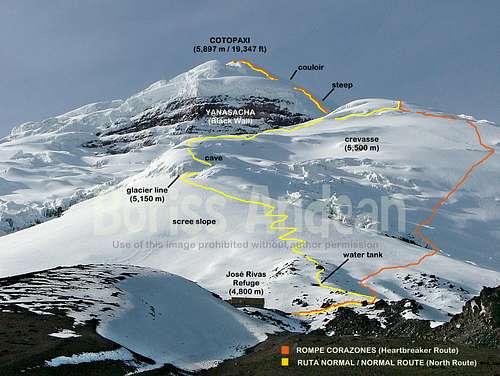
Cotopaxi Normal Route. May 2015. Boriss Andean
Mountain Conditions
As I pointed out before, the mountain is not difficult but does require crampons, ice axe and rope. The mountain is well crevassed, all the way up to the summit. For the most part, the crevasses are spectacularly large and open thus easy to avoid but beware of the multiple snow bridges...travel by night and come back early as the snow gets very slushy. Some climbing tips:The route is well beaten in but here there is some advice that could help your climb to be more enjoyable and successful: Get up at midnight, be off at 1 am and you can summit in 7-9 hours. You’ll be climbing up for the first 1 – 2 hours on steep scree (sometimes covered by snow) on switchbacks. Be patient and don’t run up. Saving energy during the first hours will help you considerably once you reach the glacier, where you may want to rope up. Some aluminum ladders as well as climbing protection (fixed lines) can be set up on exposed sections (depending on climbing season). Feel free to clip in with your carabineer if you don’t feel confident enough to negotiate them without their aid. Better being safe than sorry.
Watch out for the crevasse and the hanging seracs at 5,400 m. They already killed a climber (June. 2013) You hit the crux, or steepest section, just above the Yanasacha or the black band. Keep your head down and persevere, the route winds around just a bit and continues up by a couple easy gullies, then you hit, easy type ridge. Here the steepness eases to the summit after negotiating the last couple deep crevasses. Spend a day or two is better (if you have the time), acclimatizing and your climb will be smoother.


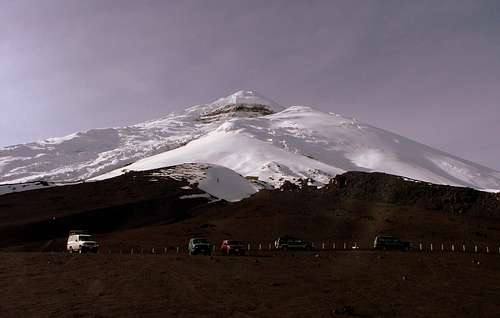























climbvr - Dec 16, 2018 2:49 pm - Hasn't voted
Normal Route in UseClimbed Cotopaxi this morning via the normal route. Our guide told us it's the only one in use and has been for a fair while!
Dra125 - Nov 30, 2021 12:41 pm - Hasn't voted
Camping No Longer AllowedAs of November 2021, camping is no longer allowed outside of the refugio. We were told by our guide (Edgar of Lonely Summits) that since COVID, the park has become more strict around camping and climbers are only allowed to stay in the refugio. We saw no campers while staying there. Bummer since we brought all of our camping gear!